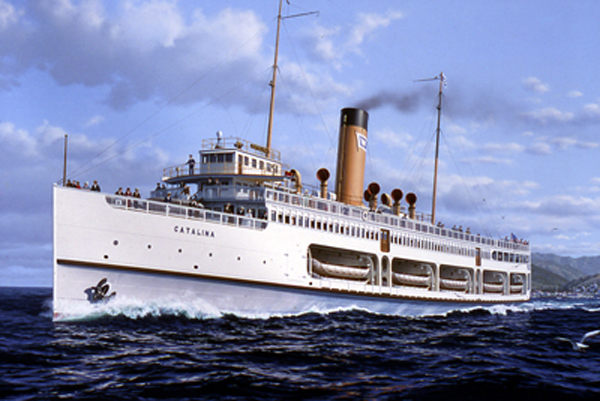|
Why Should We Save the SS Catalina?
By María Castillo-Curry
Over the last five years, I have been listening carefully to the reasons people give for saving the SS Catalina, semi-sunk in the Ensenada harbor since 1998. Some talk about their memories of traveling on the ship as children. Others admire its technology, its beauty, its uniqueness or its history. These are all convincing reasons for me as a preservationist. However, since I never traveled on the ship and since I actually saw it for the first time in Mexico, I was motivated for another reason. I felt that an international preservation movement, with the objective of saving the SS Catalina, would benefit Mexico-US relations in the Californias. The use of historic preservation as a tool to foster cooperation between grassroots organizations and institutions could help improve relations between these two neighbor countries, who have major cultural and economic differences. The SS Catalina Preservation Association (SSCPA) shares and articulates this vision in its mission statement.

SS Catalina
Currently, one of the major obstacles facing the preservation of the SS Catalina is the lack of funds available for the legal protection of US cultural resources when those resources are located in another nation. If this ship were within the territory of the United States, the SS Catalina would have National Register and California Landmark status; in Mexico it is no more than an object that obstructs the development of a marina in the Ensenada harbor. Even when the Mexican government recognizes the historical value of the vessel, its priorities are in preserving Mexican heritage, such as the missions or archeological sites. Given this complicated scenario, the rescue of the SS Catalina could help expand the vision of politicians by demonstrating the value of historic preservation as a common issue that encourages discourse and cooperation among the nations of the world.
In the last few years, the SSCPA has been trying to refloat the ship with the goal of restoring it and bringing it back to the United States. Our dialogue with the Mexican port authorities has been in terms of how to benefit both nations by removing the ship. The ship's removal would allow Ensenada's port development to take place, and the ship could be restored, fulfilling the goals of historic preservation.
The motivation for preserving a cultural resource located in one's own country is not exactly the same as the motivation to preserve a resource that has been moved abroad. As stated before, for Americans some of the motivations for preserving the ship include nostalgia, memories, and history. For Mexicans, the motivation to move the ship is mainly a matter of economics. However, for both Americans and Mexicans, there can and should be common reasons: to improve international relations, to foster cultural understanding, to increase education and cooperation, and to make many friends, something we greatly need in these difficult times.
At the 2001 National Trust conference, Donovan Rypkema stated that he was absolutely convinced that encouraging and assisting historic preservation around the world needed to be a central strategy of the United States in regaining the respect, admiration, and moral authority that this nation had lost in the last few years. He was referring to Americans working with people of other nations in preserving their own heritage, not in preserving a US cultural resource in a foreign nation. However, any preservation effort is a noble one and brings many unexpected benefits. If Americans save the SS Catalina from destruction, they show their spirit, and they will gain the respect of many Mexicans who will admire the fact that Americans did not abandon her. Historic preservation as foreign policy is a useful tool for learning in-depth about other cultures and also a healing tool, Rypkema also stated.
My dream is to see Americans and Mexicans unite in the successful effort to refloat the SS Catalina. In the SSCPA, we are working for that, and we need many people to help us raise the crucial funds needed now to make it possible. Our friends in Mexico are still helping us but the port development cannot wait much longer. Please contact the SSCPA to help, 18242 McDurmott, Suite J, Irvine, CA 92614.
World-renowned maritime artist Ken Marschall created this original painting specially to raise funds for the rescue and restoration of the S.S. Catalina. This full color fine-art print of the ship as she appeared in her first year of service in 1924 is available in three editions: unlimited unsigned for $30, numbered limited edition signed by the artist for $95, and numbered limited edition signed by the artist and former S.S. Catalina Chief Engineer Charles R. Beal for $175. Printed on heavy, archival-quality paper, these prints measure 18.5 x 25 inches and come mailed in a sturdy tube. Prints along with information and updates are available on line at www.savethecatalina.org
|
MORE FROM THIS ISSUE
Showley Brothers Candy Factory Makes a 280 Foot Historic Move
Blowing Smoke
Fire & Rain Again
Save the Coronado Railroad
Red Rest and Red Roost Update
Authenticity in Cultural Heritage Tourism
Why Should We Save the SS Catalina?
Restoration in Progress at the Whaley House
SOHO's 1st Modernism Weekend
Dual Cocktail Party Celebrates San Diego Architectural Gems
It's Year-End Tax Planning Time
New SOHO Historic District Link
A Walking Tour of the Proposed Mission Hills Historic Districts
Wish List
The Place for Holiday Shopping
SOHO Holiday Potluck Party
Volunteer Appreciation & Annual Elections
Halloween raises over $13,000 for the Whaley House
SOHO Needs You for the Craftsman-Spanish Revival Weekend
Strength in Numbers
DOWNLOAD full magazine as pdf (3.7mb)
|




